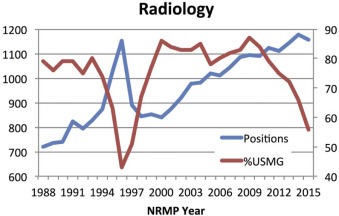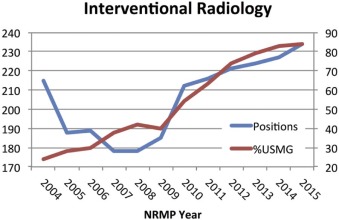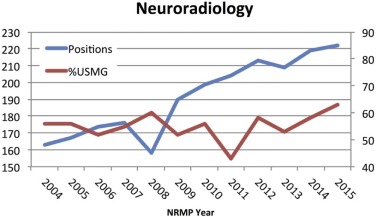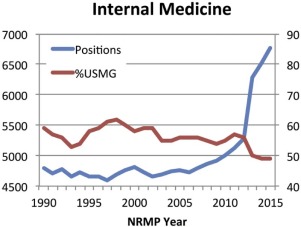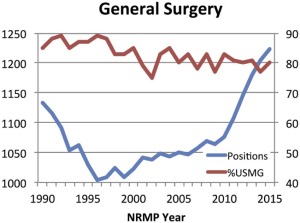Rationale and Objectives
There has been attention on the job market recently and on radiology’s supply/demand calculus. Supply is influenced by the number of trained radiologists, while demand is driven by demographics and technological innovation. We analyze the supply of radiologists historically and compare to other labor markets—medical and non-medical, domestic and foreign.
Materials and Methods
We review National Resident Matching Program data in radiology and several other specialties from 1991 to 2015. We also review surveys, physician recruitment data, and peer-reviewed commentaries on medical specialty job markets. Trends are compared across specialties. The regulation of American medical training is compared to that in the United Kingdom and to a nonmedical labor market, unionized theatrical stage employees.
Results
Radiology residency positions have increased since 1998 despite a downturn in the job market. This expansion coincides with a decreasing percentage of positions filled by domestic graduates. A similar trend has been seen in pathology, a notoriously oversupplied specialty. Conversely, other specialties have maintained their proportion of domestic graduates by way of limited supply or implicit demand.
Conclusions
The radiology job market is currently oversupplied, primarily a result of increasing residency positions despite indicators of decreasing demand. The percentage of residency positions filled by domestic graduates has decreased during the same period, suggesting that medical student interest is responsive to the market. Other specialties, particularly pathology, demonstrate the dangers of chronic oversupply. We advocate a reduction of radiology residency positions such that supply closely approximates demand without exceeding it. Additional measures may be taken, if necessary, to restore market equilibrium in the event of a mild undersupply.
The Radiology Job Market—a Historical Overview
Radiology training numbers have been influenced by technology, policy-driven reimbursements, and the economy in general.
Diagnostic radiology residency was extended from 3 to 4 years in 1982 . This corresponded with the introduction of magnetic resonance imaging, which emerged amid progress in computed tomography, ultrasound, nuclear medicine, and digital subtraction angiography.
Get Radiology Tree app to read full this article<
Get Radiology Tree app to read full this article<
Get Radiology Tree app to read full this article<
TABLE 1
Positions Offered in the NRMP, by Year and Specialty
1991 1996 1998 2001 2004 2007 2010 2013 2014 2015 Radiology 822 1154 843 875 981 1043 1090 1143 1176 1156 Pathology 513 426 355 363 477 513 503 583 597 605 Dermatology 17 20 246 262 294 320 360 407 414 427 Rad. onc. 5 113 94 93 128 142 159 183 186 200 Plastic surg. 9 49 49 59 79 94 106 127 136 148 Internal med. 4704 4654 4697 4727 4751 4798 4999 6227 6524 6770 General surg. 1116 1004 1024 1041 1044 1057 1077 1180 1205 1224
NRMP, National Residency Match Program.
After varying degrees of reduction during the mid-1990s, the number of available positions has subsequently increased in all specialties. Apparent dramatic increases in radiation oncology (1996), plastic surgery (1996), and dermatology (1998) are the result of training pathway modification (i.e. subspecialty/fellowship changing to categorical residency).
TABLE 2
Year-by-year NRMP Data for Radiology
A 1991 1992 1993 1994 1995 1996 1997 1998 1999 2000 2001 2002 Total positions 822 794 828 873 1026 1154 890 843 852 841 875 920 Total applicants 1105 1118 1205 1125 1078 874 902 1080 1244 1405 1503 1380 App:Pos 1.3 1.4 1.5 1.3 1.1 0.8 1.0 1.3 1.5 1.7 1.7 1.5 %USMG 79 75 80 74 63 43 51 67 77 86 84 83
B 2003 2004 2005 2006 2007 2008 2009 2010 2011 2012 2013 2014 2015 Total positions 979 981 1018 1011 1035 1085 1095 1090 1124 1111 1143 1176 1156 Total applicants 1428 1463 1204 1301 1331 1364 1543 1431 1299 1219 1307 1288 1141 App:Pos 1.5 1.5 1.2 1.3 1.3 1.3 1.4 1.3 1.2 1.1 1.1 1.1 1.0 %USMG 83 85 78 80 82 83 87 84 79 75 72 66 56
App:Pos, ratio of total applicants to total positions; NRMP, National Residency Match Program; Total applicants, USMGs + FMGs; Total positions, available PGY-1 + PGY-2 positions; USMG, United States medical graduate; %USMG, percentage of total positions filled by USMGs.
Get Radiology Tree app to read full this article<
Get Radiology Tree app to read full this article<
Get Radiology Tree app to read full this article<
Get Radiology Tree app to read full this article<
Get Radiology Tree app to read full this article<
Get Radiology Tree app to read full this article<
Get Radiology Tree app to read full this article<
Get Radiology Tree app to read full this article<
Get Radiology Tree app to read full this article<
Get Radiology Tree app to read full this article<
Get Radiology Tree app to read full this article<
Get Radiology Tree app to read full this article<
Oversupply of Pathologists
Get Radiology Tree app to read full this article<
TABLE 3
Percentage of NRMP Positions Filled by United States Medical Graduates, by Year and Specialty
1991 1996 2001 2004 2007 2010 2014 2015 Radiology 79 43 84 85 82 84 66 56 Pathology 53 54 44 61 58 65 43 47 Dermatology 95 90 78 82 79 81 89 83 Rad. onc. 80 54 95 88 87 88 95 90 Plastic surg. 89 94 97 94 95 89 93 92 Internal med. (Categorical) 60 59 59 55 56 55 49 49 General surg. (Categorical) 68 89 79 85 78 83 77 80
NRMP, National Residency Match Program.
Internal medicine and general surgery data represent categorical programs only, as preliminary (PGY-1 only) programs do not contribute to the graduating “workforce” of these fields. Continued residency expansion in the early 2010s appears to correlate with a decreasing proportion of domestic graduates, particularly in radiology and pathology.
Get Radiology Tree app to read full this article<
Get Radiology Tree app to read full this article<
Get Radiology Tree app to read full this article<
Get Radiology Tree app to read full this article<
Tight Supply
Dermatology
Get Radiology Tree app to read full this article<
Get Radiology Tree app to read full this article<
Radiation Oncology
Get Radiology Tree app to read full this article<
Get Radiology Tree app to read full this article<
Plastic Surgery
Get Radiology Tree app to read full this article<
Get Radiology Tree app to read full this article<
Stable Supply-Demand
Get Radiology Tree app to read full this article<
Get Radiology Tree app to read full this article<
Get Radiology Tree app to read full this article<
Get Radiology Tree app to read full this article<
Get Radiology Tree app to read full this article<
Oversupply in Rigid Markets
Get Radiology Tree app to read full this article<
Get Radiology Tree app to read full this article<
Get Radiology Tree app to read full this article<
Rigid Supply
Get Radiology Tree app to read full this article<
Get Radiology Tree app to read full this article<
Control of Residency Positions
Get Radiology Tree app to read full this article<
Conclusion
Get Radiology Tree app to read full this article<
Get Radiology Tree app to read full this article<
Get Radiology Tree app to read full this article<
Get Radiology Tree app to read full this article<
References
1. White R.I.: History of the Department. Yale School of Medicine, Department of Diagnostic Radiology. Available at: http://www.radiology.yale.edu/about/history/index.aspx Accessed December 19, 2014
2. Bhargavan M., Sunshine J.H.: Utilization of radiology services in the United States: levels and trends in modalities, regions, and populations. Radiology 2005; 234: pp. 824-832.
3. Matin A., Bates D.W., Sussman A., et. al.: Inpatient radiology utilization: trends over the past decade. AJR Am J Roentgenol 2006; 186: pp. 7-11.
4. Sunshine J.H., Maynard C.D., Paros J., et. al.: Update on the diagnostic radiologist shortage. AJR Am J Roentgenol 2004; 182: pp. 301-305.
5. The National Resident Matching Program : NRMP historical reports—2000. Available at: http://www.nrmp.org/wp-content/uploads/2013/08/resultsanddata2000.pdf Accessed December 20, 2014
6. The National Resident Matching Program : NRMP historical reports—2005. Available at: http://www.nrmp.org/wp-content/uploads/2013/08/resultsanddata2005.pdf Accessed December 20, 2014
7. The National Resident Matching Program : NRMP historical reports—1998. Available at: http://www.nrmp.org/wp-content/uploads/2013/08/resultsanddata1998.pdf Accessed December 20, 2014
8. Lee D.W., Levy F.: The sharp slowdown in growth of medical imaging: an early analysis suggests combination of policies was the cause. Health Aff (Millwood) 2012; 31: pp. 1876-1884.
9. Levin D.C., Rao V.M., Parker L., et. al.: Bending the curve: the recent marked slowdown in growth of noninvasive diagnostic imaging. AJR Am J Roentgenol 2011; 196: pp. W25-W29.
10. Sunshine J.H., Maynard C.D.: Update on the diagnostic radiology employment market: findings through 2006–2007. J Am Coll Radiol 2007; 4: pp. 686-690.
11. Hawkins M.: 2010 review of physician recruiting incentives: an overview of the salaries, bonuses, and other incentives customarily used to recruit physicians. Available at: http://www.merritthawkins.com/uploadedfiles/merritthawkings/surveys/mha2010incentivesurvpdf.pdf Accessed December 20, 2014
12. Hawkins M.: 2012 review of physician recruiting incentives: an overview of the salaries, bonuses, and other incentives customarily used to recruit physicians. Available at: http://www.merritthawkins.com/uploadedFiles/MerrittHawkins/Pdf/mha2012incentivesurveyPDF.pdf Accessed December 20, 2014
13. Fratt L.: Demand for radiologists nose-dives. HealthImaging.com; July 24; Healthcare Economics; Available at: http://www.healthimaging.com/topics/healthcare-economics/demand-radiologists-nose-dives Accessed December 20, 2014
14. Millburg S.: Recruiter: demand for radiologists plunges. RadiologyDaily.com; July 25; Practice Management; Available at: http://www.radiologydaily.com/daily/practice-management/recruiter-demand-for-radiologists-plunges/ Accessed December 20, 2014
15. Bernstein N.: Job prospects are dimming for radiology trainees.2013. Mar 27; Available at: http://www.nytimes.com/2013/03/28/health/trainees-in-radiology-and-other-specialties-see-dream-jobs-disappearing.html?pagewanted=all Accessed December 20, 2014
16. The National Resident Matching Program : NRMP historical reports—2009. Available at: http://www.nrmp.org/wp-content/uploads/2013/08/resultsanddata2009.pdf Accessed December 20, 2014
17. The National Resident Matching Program : NRMP historical reports—2014. Available at: http://www.nrmp.org/wp-content/uploads/2014/04/Main-Match-Results-and-Data-2014.pdf Accessed December 20, 2014
18. The National Resident Matching Program : 2015 main residency match advance data tables. Available at: http://www.nrmp.org/wp-content/uploads/2015/03/ADT2015_final.pdf Accessed April 3, 2015
19. The National Resident Matching Program : NRMP historical reports—2013. Available at: http://www.nrmp.org/wp-content/uploads/2013/08/resultsanddata2013.pdf Accessed December 20, 2014
20. Bluth E.I., Truong H., Bansal S.: The 2014 ACR commission on human resources workforce survey. J Am Coll Radiol 2014; 11: pp. 948-952.
21. Sunshine J.H., Maynard C.D.: Update on the diagnostic radiology employment market: findings through 2007–2008. J Am Coll Radiol 2008; 5: pp. 827-833.
22. Vance R.P.: Some thoughts about the past and future of pathology workforce. Hum Pathol 1999; 30: pp. 117-122.
23. Robboy S.J., Weintraub S., Horvath A.E., et. al.: Pathologist workforce in the United States: development of a predictive model to examine factors influencing supply. Arch Pathol Lab Med 2013; 137: pp. 1723-1732.
24. The National Resident Matching Program : NRMP historical reports—2001. Available at: http://www.nrmp.org/wp-content/uploads/2013/08/resultsanddata2001.pdf Accessed December 20, 2014
25. Frank K., Wagner J. ASCP fellowship & job market surveys: a report on the 2014 RISE, FISE, FISHE, NPISE, PISE, and TMISE surveys.
26. Duncan J.R., Derdyn C.P., Evens R.G.: Results of the 1994 survey of the American Association of Academic Chief Residents in radiology. Acad Radiol 1996; 3: pp. 72-76.
27. Shetty A., Hammer M., Gould J., et. al.: Results of the 2014 survey of the American Alliance of Academic Chief Residents in radiology. Acad Radiol 2014; S1076-6332(14)00214-1 [pii]
28. The National Resident Matching Program : Results and data: specialties matching service. 2015 Appointment Year; Available at: http://www.nrmp.org/wp-content/uploads/2015/02/Results-and-Data-SMS-2015.pdf Accessed August 29, 2015
29. The National Resident Matching Program : Results and data: specialties matching service. 2010 Appointment Year; Available at: http://www.nrmp.org/wp-content/uploads/2013/08/resultsanddatasms2010.pdf Accessed August 29, 2015
30. The National Resident Matching Program : Results and data: specialties matching service. 2008 Appointment Year; Available at: http://www.nrmp.org/wp-content/uploads/2013/08/resultsanddatasms2008.pdf Accessed August 29, 2015
31. American Academy of Dermatology : About the AAD. Available at: http://www.aad.org/about-aad Accessed December 20, 2014
32. Kimball A.B., Resneck J.S.: The US dermatology workforce: a specialty remains in shortage. J Am Acad Dermatol 2008; 59: pp. 741-745.
33. Smith B.D., Haffty B.G., Wilson L.D., et. al.: The future of radiation oncology in the United States from 2010 to 2020: will supply keep pace with demand?. J Clin Oncol 2010; 35: pp. 5160-5165.
34. Smith B.D., Smith G.L., Hurria A., et. al.: Future of cancer incidence in the United States: burdens upon an aging, changing nation. J Clin Oncol 2009; 27: pp. 2758-2765.
35. Shah C.: Expanding the number of trainees in radiation oncology: has the pendulum swung too far?. Int J Radiat Oncol Biol Phys 2013; 85: pp. 1157-1158.
36. Rohrich R.J., McGrath M.H., Lawrence W.T., et. al.: Assessing the plastic surgery workforce: a template for the future of plastic surgery. Plast Reconstr Surg 2010; 125: pp. 736-746.
37. Maynard A., Walker A.: Managing medical workforces: from relative stability to disequilibrium in the UK NHS. Appl Health Econ Health Policy 2003; 2: pp. 25-36.
38. Bloor K., Maynard A.: Workforce productivity and incentive structures in the UK National Health Service. J Health Serv Res Policy 2001; 6: pp. 105-113.
39. Schroeder S.A.: Western European responses to physician oversupply. Lessons for the United States. JAMA 1984; 252: pp. 373-384.
40. Greenhouse S., Robertson C.: In broadway dispute, questions of fairness.2007. Nov 25; Available at: http://www.nytimes.com/2007/11/25/nyregion/25broadway.html?pagewanted=all&_r=0 Accessed December 28, 2014
41. Manly L., Cooper M.: Hey stars, be nice to the stagehands. You might need a loan.2013. Dec 27; Available at: http://www.nytimes.com/2013/12/28/arts/hey-stars-be-nice-to-the-stagehands-you-might-need-a-loan.html?pagewanted=all&_r=0 Accessed December 28, 2014
42. Accreditation Council for Graduate Medical Education : Program and institutional accreditation. Available at: https://www.acgme.org/acgmeweb/tabid/83/ProgramandInstitutionalAccreditation.aspx Accessed August 18, 2015
